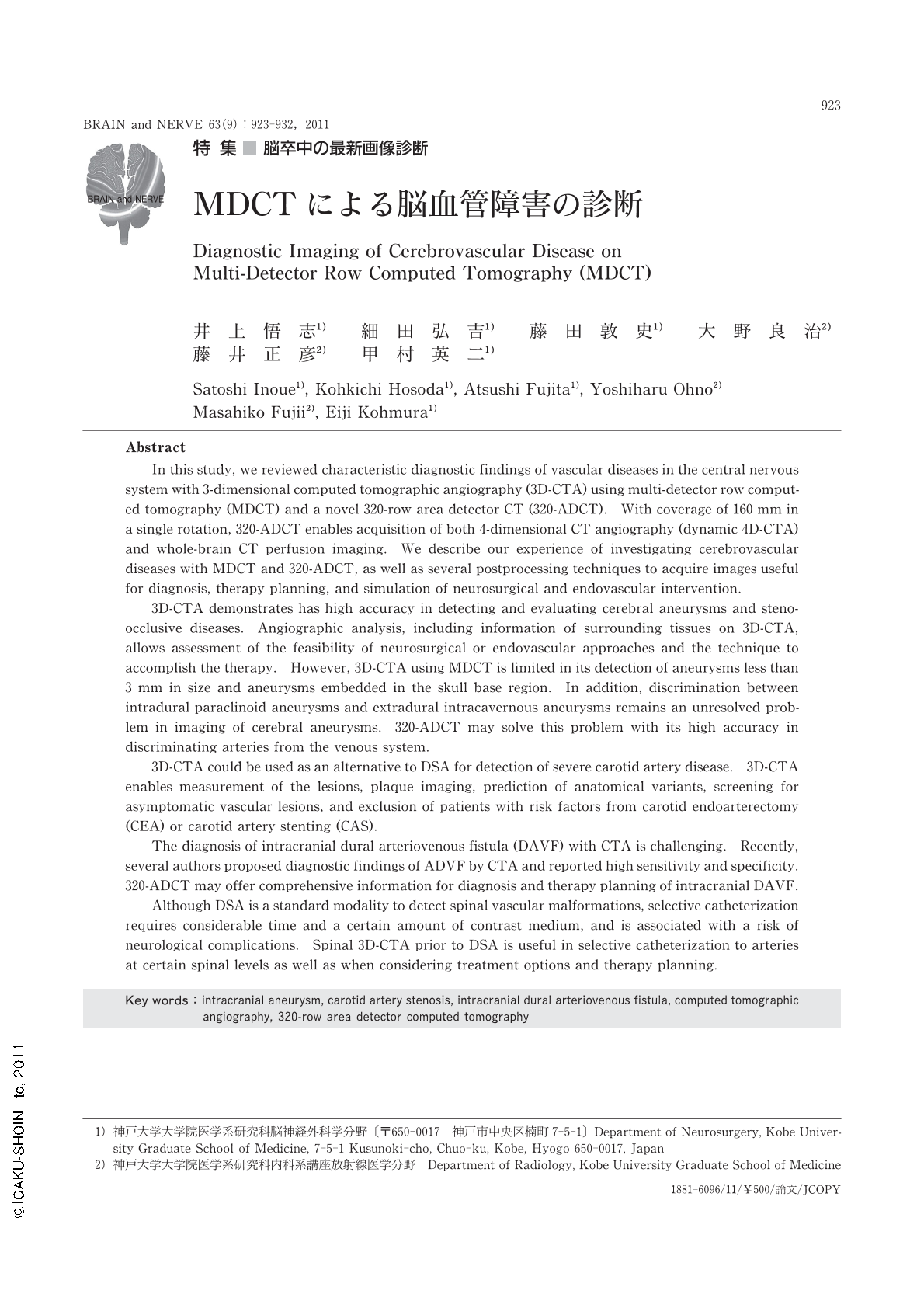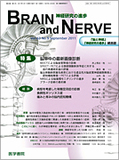Japanese
English
- 有料閲覧
- Abstract 文献概要
- 1ページ目 Look Inside
- 参考文献 Reference
はじめに
「脳の世紀」は画像診断技術の発達抜きには語れない。Digital subtraction angiography(DSA)では回転撮影が日常的となり,magnetic resonance angiography(MRA)も3 tesla(T)の高磁場装置が普及した。しかし,脳の画像診断において最も頻用されるのはCTである。
CT技術の開発により,HounsfieldとCormackの両名がノーベル生理学・医学賞を受賞したのは1979年である。1986年にはヘリカルCTが開発され,1998年には多列検出器CT(MDCT:multi-detector row CT)が登場し,2002年には16列MDCT,現在では320列面検出器CT(320-row area detector CT:320列ADCT)が市販されている。
320列ADCTでは,0.5mm×320列=160mmの範囲を1 scan(最短0.35秒)で撮像可能である。造影剤投与後に複数回のscanを行うと,時間軸に沿って連続した3D-CTA volume dataのシリーズとなる(dynamic 4D-CTA)。この経時的データからはDSA類似の血行動態評価に加えて,全脳の脳血流評価が可能である(whole brain CT perfusion:CTP)。Helical scanを用いないことでデータの座標が正確となり,骨除去(bone subtraction)などvolume subtractionの精度が向上した。一方で,サーバーの大容量化,画像処理用workstationの高速化に伴う後処理技術の進歩も近年特筆すべきものがある。
本稿では,脳血管障害に対するMDCT,特に3D-CT angiography(3D-CTA)の有用性について述べる。また,エンドユーザーとしての脳神経外科医の視点から,日常診療で利用している3D-CTA画像を紹介する。さらに,320列ADCTによる画像診断についても紹介したい。画像はすべて当院放射線部のZIOSTATION 1.3(Ziosoft社)を用いて筆者が作成したものである。
各論に先立って主要な後処理方法について略記する。
Abstract
In this study, we reviewed characteristic diagnostic findings of vascular diseases in the central nervous system with 3-dimensional computed tomographic angiography (3D-CTA) using multi-detector row computed tomography (MDCT) and a novel 320-row area detector CT (320-ADCT). With coverage of 160 mm in a single rotation, 320-ADCT enables acquisition of both 4-dimensional CT angiography (dynamic 4D-CTA) and whole-brain CT perfusion imaging. We describe our experience of investigating cerebrovascular diseases with MDCT and 320-ADCT, as well as several postprocessing techniques to acquire images useful for diagnosis, therapy planning, and simulation of neurosurgical and endovascular intervention.
3D-CTA demonstrates has high accuracy in detecting and evaluating cerebral aneurysms and steno-occlusive diseases. Angiographic analysis, including information of surrounding tissues on 3D-CTA, allows assessment of the feasibility of neurosurgical or endovascular approaches and the technique to accomplish the therapy. However, 3D-CTA using MDCT is limited in its detection of aneurysms less than 3 mm in size and aneurysms embedded in the skull base region. In addition, discrimination between intradural paraclinoid aneurysms and extradural intracavernous aneurysms remains an unresolved problem in imaging of cerebral aneurysms. 320-ADCT may solve this problem with its high accuracy in discriminating arteries from the venous system.
3D-CTA could be used as an alternative to DSA for detection of severe carotid artery disease. 3D-CTA enables measurement of the lesions, plaque imaging, prediction of anatomical variants, screening for asymptomatic vascular lesions, and exclusion of patients with risk factors from carotid endoarterectomy (CEA) or carotid artery stenting (CAS).
The diagnosis of intracranial dural arteriovenous fistula (DAVF) with CTA is challenging. Recently, several authors proposed diagnostic findings of ADVF by CTA and reported high sensitivity and specificity. 320-ADCT may offer comprehensive information for diagnosis and therapy planning of intracranial DAVF.
Although DSA is a standard modality to detect spinal vascular malformations,selective catheterization requires considerable time and a certain amount of contrast medium,and is associated with a risk of neurological complications. Spinal 3D-CTA prior to DSA is useful in selective catheterization to arteries at certain spinal levels as well as when considering treatment options and therapy planning.

Copyright © 2011, Igaku-Shoin Ltd. All rights reserved.


